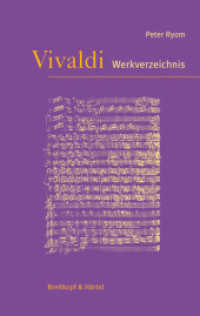- ホーム
- > 洋書
- > ドイツ書
- > Humanities, Arts & Music
- > History
- > miscellaneous
Full Description
This book offers new insights into the mechanisms of state control, systematic repression and mass violence focused on ethnic, political, class, and religious minorities in the recent past. The geographical and temporal scope of the volume breaks new ground as international scholars foreground how contemporary archaeology can be used to enhance the documentation and interpretation of totalitarian and authoritarian regimes, to advance theoretical approaches to atrocities, and to broaden public understandings of how such regimes use violence and repression to hold on to power.
Contents
1. Introduction.- 2. Mass Graves: Strategies of Extermination during the Spanish Civil War and Franco's Dictatorship.- 3. Concentration Camps: Classifying the Subjects of the New Spain.- 4. Double Vision and the Politics of Visibility: the Landscapes of Forced and Slave Labour.- 5. The Heart of Terror: A Forensic and Archaeological Assessment of the Old Gas Chambers at Treblinka.- 6. Materiality of a Forced Migration in WWII. Archaeology of Displacement of the Polish Exodus in Iran (From 1942).- 7. Searching for Living Ghosts: The Archaeology of Communist Repression in Poland.- 8. Archaeology of the Lithuanian Partisan War: Case of the Partisan Bunker in Daugėliškiai Forest.- 9. Divided Landscapes, Divided Peoples: An Archaeology of the Iron Curtain between Czechoslovakia and Western Germany.- 10. The Shadow of Pain. Instructions for Archaeologists Living under Dictatorship.



![The Diversity of Irony (Cognitive Linguistics Research [CLR] 65) (2022. VIII, 307 S. 48 b/w and 16 col. ill., 8 b/w tbl. 230 mm)](../images/goods/ar/work/imgdatak/31107/3110777517.jpg)




